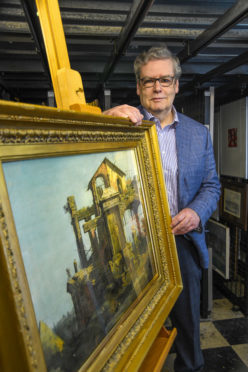A painting in Aberdeen University’s art collection has been identified as a £2million work by a famous Italian artist – more than 150 years after it was donated.
The image of Roman ruins outside a city has been authenticated by two experts as an original creation by Venetian maestro Canaletto.
John Gash, senior lecturer in history of art at the university, and leading Canaletto expert Charles Beddington have published their findings in The Burlington Magazine – the leading journal on fine arts.
Mr Gash said: “It was often thought to be from the Canaletto school – that is, by one of Canaletto’s pupils or someone imitating his style.
“However, I and others have long suspected it was a real Canaletto and now we’ve been able to confirm this.
“It is clear from the technique and style that this is a Canaletto and is in fact an autograph work of the highest quality.”
In researching the painting, Mr Gash read an 1865 article from the Aberdeen Journal, which explained the picture had been left to the university two years earlier by Alexander Henderson of Dyce.
The newspaper piece described the painting as ‘The Ruins of a Temple’, by ‘B Canaletti’.
Canaletto’s real name was Giovanni Antonio Canal, but his nephew and pupil, Bernardo Bellotto, was confusingly also later known as Canaletto.
So it is unclear whether Henderson believed it to be by Canaletto’s nephew, or had merely got the name of the original Canaletto confused.
The painting is not signed by the artist, but this is not uncommon.
Mr Gash added: “Occasionally, Canaletto did sign his works but not in this example. However, in the middle of the painting is a ruin which displays the coat of arms of his family.
“It’s unlikely someone else would include that, so it acts as a kind of surrogate signature.”
Canaletto was renowned for his precisely reproduced images of Venice.
The Ruins of a Temple painting is not of Venice’s famous canals, but a capriccio – a collection of many different elements brought together for artistic purposes.
Mr Gash said: “It is difficult to put an accurate price on paintings such as this, but given its physical size, subject matter and the quality of the piece, I would suggest it could be worth between £1.5million and £2million.”
Plans are being made by the university to publicly display the Canaletto work.
